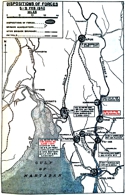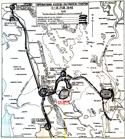4th Battalion, The Burma Rifles
The 4th Battalion was originally raised at Meiktila on 23rd April 1918 as the 5th Battalion, 70th Burma Rifles. In 1922, it was designated the 10th Battalion, 20th Burma Rifles. It was one of the regular battalions of the Burma Rifles transferred from India on 1st April 1937 when it became the 4th Battalion, The Burma Rifles.
In 1937, the 4th Battalion was stationed at Maymyo and in November 1938 relocated to Mandalay, under command of the Maymyo Infantry Brigade Area. The battalion's four rifle companies were composed thus:
- 'A' Company (Chins)
- 'B' Company (Karens)
- 'C' Company (Karens)
- 'D' Company (Kachins).
By March 1941, the Battalion formed part of the Tenasserim Brigade and on 1st July 1941 came under the command of the 2nd Burma Brigade Group when that formation was formed.
During November 1941, the Battalion moved to the Kawkareik-Myawadi area, near the frontier with Thailand and covering the likely invasion route from Raheng. Headquarters 2nd Burma Infantry Brigade was at Moulmein, about 80 miles to the west. Whilst continuing to train, the Battalion prepared for its likely war time role. Up in the hills near the Thai border, defences and demolitions were prepared, covering the likely invasion route. The war plan was to conduct a withdrawal, denying the use of the Kawkareik road to the enemy. Unfortunately in the period before the Japanese invasion, the Battalion suffered many casualties from malaria and was at only around two thirds in strength by early January 1942.[1]
Following the attack on Pearl Harbour, patrols were maintained along the border and an attempt was made to maintain relations with the Thais in order to keep open the flow of information. In early January 1942, a number of ambushes were laid to deter the Japanese, who by now had invaded Thailand, from interfering with Burmese villagers and economic activity along the border.
Given intelligence of the Japanese build up in the area, Lt. General Hutton, General Officer Commanding Burma, decided to strengthen the defences at Moulmein, Kawkareik and Tenasserim in general. The 16th Indian Infantry Brigade was ordered from Rangoon to Moulmein to take over the sector from the 2nd Burma Infantry Brigade. When the General Officer Commanding 17th Indian Infantry Division, Major General J.G. 'Jackie' Smyth, VC, MC, arrived in Rangoon on 9th January 1942, he and his headquarters were sent to Moulmein to take charge of 16th Indian and 2nd Burma Infantry Brigades. The 16th Indian Infantry Brigade arrived in Moulmein on 14th January 1942 and after a short period of confusion, the 4th Battalion came under the command of this newly arrived brigade. The rationale for retaining the 4th Battalion was that it was already in place and had good knowledge of the local country. To compensate for this, the 4th Battalion, 12th Frontier Force Regiment was transferred from 16th Indian Infantry Brigade to the 2nd Burma Infantry Brigade. When the Japanese invaded on January 20th 1942, the companies of the 4th Battalion found themselves separated across the area. A difficult withdrawal ensued, with the companies of the Battalion and those of others in the Brigade becoming intermixed. There was much confusion and hasty withdrawal by the units of 16th Indian Brigade however the 4th Battalion acquitted itself well.
Battalion Headquarters reached the outskirts of Kawkareik on the night of 21st/22nd January, only to find that the Brigade had moved on. Orders were then received to proceed to Martaban and a launch was made available to carry the men across the Salween. At a camp west of Martaban, on around 25th January, the companies of the Battalion, less 'D' Company, were at last reunited. 'D' Company rejoined in early February after a fourteen day march, in good order, having had successful encounters with Japanese patrols, and despite having been out of contact with the Battalion and the Brigade at the time of the Japanese invasion. The Battalion was alone in 16th Indian Infantry Brigade in retaining many of its supporting weapons and was now stunned to be ordered to hand these over to the less prudent Indian battalions. Despite promises to the contrary these weapons - mortars, Brens and Tommy guns - were never replaced.
The Battalion was soon split again, with companies dispersed along the Salween River, with Battalion Headquarters and one company in reserve at Thaton Railway station. Communication with the dispersed companies was difficult due to the lack of wireless. Between 5th and 9th February, the 17th Indian Infantry Division ordered several changes to the composition of the brigades under its command, and by 9th February, the 4th Battalion, less a company, was under the command of the 46th Indian Infantry Brigade. ‘C’ Company was detached and at first remained under the command of the 16th Indian Infantry Brigade before coming under the direct command of the Headquarters 17th Indian Infantry Division.
As the Japanese drew up to the Salween line, patrol clashes became more common. When the Japanese crossed in more strength, Martaban was taken and British forces withdrew to the Bilin River line. By 13th February 1942, the 4th Battalion, less ‘C’ Company, was concentrated east of Thaton. The withdrawal continued via Nimpale and by rail to Kyaikto, which was reached on 16th February and where the Battalion went into defence. The Japanese attacked on the night of 20th/21st February, prompting a further withdrawal by the Battalion to Mokpalin, on the Sittang River, as part of the general and confused withdrawal of the 17th Indian Infantry Division towards the railway bridge there. The Battalion was involved in the defence of the Mokpalin bridgehead until the morning of 23rd February when the bridge was blown. There then followed a desperate crossing of the river by raft and many men drowned trying to swim. Those who crossed marched to Waw for reorganisation.
However it was soon decided to withdraw the battalion to Mandalay, along with the 3rd Battalion, The Burma Rifles. Mandalay was reached by 11th March 1942, by which time the Battalion, still without 'C' Company, was around 250 all ranks in strength. The 'missing' 'C' Company had meanwhile withdrawn northwards via Shwegyin to Toungoo, under the command of the 2nd Burma Infantry Brigade. On 17th March 1942, at Gonde, the company was posted as reinforcements to the 7th Battalion, The Burma Rifles. The survivors of this company did not rejoin the 4th Battalion until Imphal.
The 4th Battalion was now designated as Lines of Communication troops and came under the command of Mandalay Area on 12th March. Managing to only partially rearm itself, the Battalion provided a column to deal with any Japanese airborne landing and also provided train guards. On April 30th, the 17th Indian Infantry Division withdrew across the Irrawaddy via the Ava Bridge which was blown up just before midnight. The 4th Battalion was then ordered to Bhamo and boarded an Irrawaddy Flotilla Company launch, the S.S. "Japan". The Battalion arrived at Katha on 1st May 1942, beyond which place the steamer crew refused to travel. The next day the Battalion marched to the Naba-Indaw area, as ordered by Myitkyina Area command. For two days from 4th May, the Battalion did good work helping to organise the evacuation of the wounded and refugees. However on 6th May, the Commanding Officer, Lt. Colonel P.P. Abernethy, gave the order to march to India. Ukrul was reached on 20th May and Imphal three days later. On 30th May, the Battalion moved by lorry to Milestone 107 on the Manipur Road. Of around 450 all ranks who had left Mandalay, around 345 reached India, a significant achievement. In June, the Battalion was disbanded. Around 75 men elected to return to their homes in Burma and the rest transferred to other units, the majority to the Composite Battalion, Burma Rifles, which later came to be the 2nd Battalion Burma Rifles.
[The war diaries of the battalion were destroyed during the retreat, however the Commanding Officer, Lt Col. PP Abernethy, later wrote an account from memory, in Rawalpindi in December 1942. The file is available at the National Archives at Kew as WO 172/977. A transcription of the file, together with extensive footnotes gleaned from other sources, can be read or downloaded here.]
06 November 2017


